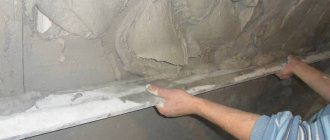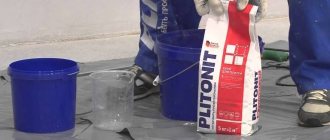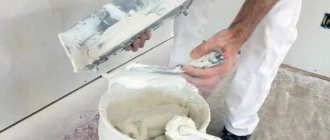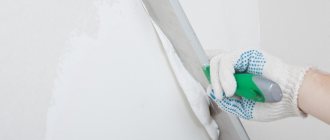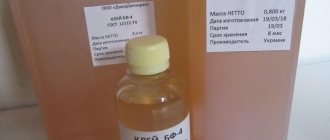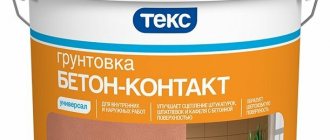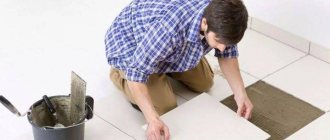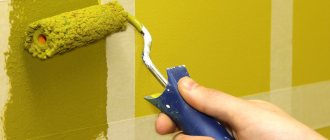Despite rapid technological progress, cement-lime mortar continues to be used in construction. And this is not due to a shortage of other solutions, but to the many advantages of such a composition. It meets all modern standards and requirements, and also has an extended service life.
Advantages
Lime-cement mortar is a special building material with increased strength and elasticity. It can be used both as a binder during the construction of buildings and during finishing work.
The main advantages include the following points:
- The mortar can be used as a masonry mortar or a base for plaster. In the first case, it provides reliable adhesion of blocks or bricks. In the second, it is used for external or internal finishing activities.
- The solution can be used to fill monolithic floors, since lime prolongs the hardening period and increases strength properties. This reduces the risk of cracks and promotes even distribution of the putty.
Brands of masonry mortars
- Masonry mortar M 25. Used for plastering walls, ceilings, partitions, columns, and creating a cement floor screed. Has high mobility and plasticity. You can add decorative pigments to it and use it for decorative work. It does not contain artificial additives, but the mixture has good strength characteristics.
- Masonry mortar M 50. This is a universal mixture, resistant to external influences, practical. It can be used for laying brick and stone walls in low-rise construction. The composition contains plasticizing additives and retarding agents. The solution is also used in repair and installation work to seal gaps and cracks in structures; it can be used as an armored belt.
- Masonry mortar M 75. Most often used for laying concrete blocks, in reinforced concrete structures, when constructing internal walls of buildings and structures and for concrete floor screed.
- Masonry mortar M 100. Is the most common. It is used in civil engineering: in the construction of monolithic multi-storey buildings and private houses.
- Masonry mortar M 150. The composition contains limited gypsum and lime. Used for foundations in soils with reduced strength.
Penetration ability
The cement-lime mixture is characterized by excellent adhesion to the surface, so it completely fills small depressions and cracks, providing high fixation strength. The solution also has good adhesion, which allows it to be used in conjunction with wood products. So, plaster for wooden sheathing is made using this technology.
Due to its improved strength properties, ductility and resistance to moisture, the mixture is suitable for any finishing work on buildings, both inside and outside. It is in demand for finishing work in the bathroom, on facades or the foundation where it adjoins the blind area.
Lime-gypsum mortars
If there is a need to obtain a composition that sets quickly, then prepare a lime mixture with gypsum (hardening time - about 10 minutes):
- prepare the usual composition based on fluff and divide it into two parts;
- combine the first part with gypsum in a ratio of 2:1 and mix;
- add the second part of the composition based on fluff to this composition with gypsum and mix again;
- use the resulting mixture for 5-8 minutes (while continuing to constantly stir the mixture).
Advice! We recommend working with the lime-gypsum solution quickly and mixing it in small portions.
Such compositions are characterized by: fine grain size and lack of shrinkage. Disadvantages: the need to use them as soon as possible and the impossibility of using them in wet rooms. Most often, such mixtures are used for interior plastering of premises (they are rarely used outside).
Specifications
A high-quality solution is created based on the following components:
- Cement mixture.
- Sand.
- Slaked lime.
- Water.
When using lime, it is important to choose only the slaked version. If this is not done, quenching will occur in the solution after adding liquid, forming bubbles. As a result, the plastered surface will begin to crack. This process reduces the quality of the final solution and makes it brittle.
Lime prevents the development of pathogenic bacteria and fungi, and also protects the room from rodents and pests. The composition and properties of modern building mixtures are regulated by GOST standards. This makes it possible to standardize their technical characteristics and verify compliance with requirements.
The document also specifies quality indicators, laying features and conditions for moving solutions. It regulates the properties of masonry mortars, materials for applying plaster and interior decoration, depending on the environment of use.
Requirements for mortar for bricklaying
The main requirements for the solution are the requirements for strength and durability.
Based on strength, solutions are marked from M4 to M200. Frost resistance - from F10 to F200.
Important!
In terms of strength, the solution must meet the requirements of the project, and in terms of durability - the operating conditions of the structure.
It is interesting that the strength of brickwork on fresh, unhardened mortar is 3 times less than the strength of the same masonry on hardened M100 grade mortar.
In addition to strength and durability, an important requirement is sufficient mobility of the solution and its moisture-holding capacity.
The point is not only that a mobile solution that is not prone to delamination is more convenient to work with and saves time, but also that such a solution compacts and fills the seams better, as a result of which the strength of the masonry can increase by 1.5–2 times .
Properties
Mortars made from cement and lime are characterized by the following properties:
- Mobility.
- Resistance to water from 90%.
- The degree of delamination is up to 10%.
- Operating temperature up to 0°C.
- Medium density.
- Degree of humidity (this indicator is typical for dry mixtures).
When creating a cement-lime mortar, the proportions are selected taking into account the type of surface on which it will be applied, as well as the conditions of their use. In the construction industry there is such a thing as the fat content of the mixture. It is determined by the volume of binder additives that are present in the masonry mortar.
Depending on the fat content, there are 3 groups of solutions:
- Normal. These include a material with universal plasticity that can be used in different environments. Such solutions do not have the problem of shrinkage and cracking of the coating.
- Skinny. They are characterized by minimal shrinkage and can be used for any indoor cladding activities.
- Fatty. They are highly plastic compositions with a high content of binding elements. The solution is intended for masonry.
To change the degree of fat content, special components are added to the composition that affect plasticity. This could be porous sand, which lowers the parameter, or lime, which acts in the opposite direction.
Compound
Masonry mortar is an artificial stone material obtained after hardening of a mortar mixture, which includes a binder, sand, water and various additives. Masonry mortars are used for rubble, stone and brick masonry.
Sand for masonry mortar should be no larger than 2.5 mm.
Organic substances (technical lignosulfonates - LST, sulfite-yeast mash - SDB and soap naft) and inorganic (volcanic ash, ash, ground slag, etc.) can be used as additives. Winter solutions contain antifreeze and air-entraining additives.
Masonry mortar for bricks must be plastic. For brickwork, a cement-lime composition or a warm lime mortar is best suited.
Density and grades
Cement-lime mortar can have different densities. It depends on the raw materials and the ratio of components. The most commonly used types of materials are:
- With low density - up to 1500 kg/m³.
- With high density - from 1500 kg/m³.
Taking into account proportions, materials are divided into different grades. This can be lime mortar M50, M75, mortar M100, etc. The last 2 grades 50 and 100 are characterized by increased strength and resistance to moisture. The additives from the composition have a homogeneous structure, because they do not contain crushed stone.
Grades 100 and 75 are used in the construction of industrial and civil facilities. The compositions are created on the basis of cement, sand and lime, combined in different proportions.
Surfaces can be plastered with M25 and M50 solutions. They are affordable and easy to manufacture.
Such solutions are in demand at humidity levels above 75%, which is why they are used in the construction of bathhouses and other buildings with high humidity. Lime also fights fungal growths on walls.
Color of masonry mortar
In order for the solution to acquire any color, the necessary pigments are added to it. Pigments for masonry mortars can be of the following types: lime, cement and cement-lime.
They should make up about 8% of the total mass of the mixture.
- Colored masonry mortar. It is used in brickwork for facing work. Additionally, this mixture includes colored fillers. Alkali-resistant dyes are usually used as an additive to masonry mortar. Adding ocher to the solution allows you to get a yellow-orange color, minium - brown-bearded or red, ultramarine - blue and violet, chromium oxide - green.
- White masonry mortar. The role of pigment in white masonry mortar is played by excess slaked lime, zinc or titanium oxide.
- Black masonry mortar. To obtain a black color of the mixture, construction black is added to it.
- Gray masonry mortar. The color of the masonry mortar depends on the additives; if they are not present, then the mortar will be the color of concrete, that is, ordinary gray.
Diversity
Plaster lime mortars are divided into several types:
- Basic. Suitable for roughing surfaces and filling defects and recesses.
- Decorative. Designed to color surfaces, change their appearance and create a shimmering effect. Such plasters contain special additives, plasticizers and hydrophobic elements.
- Special. Designed to improve the performance qualities of treated buildings, they perform moisture-proof, sound-proofing and heat-insulating functions.
Compositions (recipes) of building mortars for brickwork.
The classification, technical characteristics and composition of mortars for brickwork are regulated by SP 82-101-98 (“Preparation and use of building mortars”).
Classification of mortars for brickwork:
1) by density (dry):
- heavy - density, which ranges from 1500 kg/m 3;
- light – with a density of up to 1500 kg/m3.
2) by type of binder:
- simple - lime, cement, etc.;
- complex - cement-clay, cement-lime, etc.
3) grade for compressive strength - M4, M10, M25, M50, M75, M100, M150, M200, M300.
How masonry mortar gains strength.
The strength values of mortars for brickwork aged up to 90 days are given below (100% is taken to be the strength of a mortar aged 28 days, which hardened at a temperature of 20 ± 3 °C):
Accordingly, at a different hardening temperature, the strength values change according to the principle - the higher the temperature, the faster the strength is gained:
It should be taken into account that solutions based on pozzolanic Portland cement, slag Portland cement and mortar cements slow down the development of strength at a hardening temperature below 15 ° C.
To obtain the value of their relative strength, it is necessary to multiply the value from the table by the corresponding coefficient: 0.3 - at a temperature of 0 ° C; 0.7 - at a temperature of 5 ° C; 0.9 - at a temperature of 10 ° C; 1 - at a temperature of 15 °C and above.
Composition (recipe) of mortars for brickwork.
The table below shows the recipes/compositions (ratio of bulk volume (cement: lime: sand)) of cement-clay, cement-lime and cement mortars:
Selection of binders for preparing masonry mortars.
The use of lime-slag binders is not allowed at air temperatures below 10 ° C, as the hardening of the solution is greatly retarded. To accelerate hardening and maintain the strength of solutions using the specified binders, it is recommended to add Portland cement in an amount of 15-25% by volume of the binder and at the same time increase the dosage of sand by 15-25%.
What brand of mortar to choose for brickwork.
Brick and mortar have different strength and water absorption characteristics. Therefore, when they work together in masonry, a certain contradiction results - “The stronger the mortar, the weaker the masonry,” since the strength of the brick may not be enough to withstand the shrinkage stresses from a too strong mortar. In this case, deformations of the brickwork may occur - it “tears”.
When choosing a brand of mortar for brickwork, you should be guided by the design, and in the absence of one, remember that the brand of mortar should be 2 times lower than the brand of brick. So, when using M75 brick, an M20-M35 mortar is suitable (for the brickwork of a two-story house, an M25 mortar is sufficient).
Masonry mortar is a composition of aggregate and binder, where the latter may be lime or cement. The filler will be sand without impurities and debris.
Depending on the type of binder, there are:
Cement
Made from sand and cement. The main disadvantage of the resulting solution is low plasticity, but good strength. To make the solution better, experienced masons add washing powder. But this must be done according to the rules, and not by eye.
If you compare the powder with cocoa, then when you add water, lumps will appear. The same processes occur with cement due to its poor wettability. Therefore, you should first mix sand with cement, and then carefully add water to the composition.
Lime
Rarely used due to low strength. But this solution is taken to improve the quality of compositions with Portland cement.
Cement-lime
Consists of slaked lime, sand and binder. For quenching, water is usually used, which is added until the solution takes on the consistency of milk. After this, the resulting composition is poured into sand and a binder.
In the latter case, the brick mortar is much more plastic than classic compositions with Portland cement and has an increased level of strength. This makes cement-lime mortar the best option for any brick laying.
Requirements for mortars for brickwork
To build a strong wall in a building, the masonry mass must meet the following criteria:
- High plasticity. This will fill holes and seams in the bricks.
- Good indicator of strength. After hardening, the composition should not deform the walls.
- Quick grip. The hardening time affects the consumption of the solution. You need to have time to use the entire volume before it hardens.
Dry mixture or DIY composition
The key advantage of cement-lime compositions is their affordable cost. They are cheaper than mixtures based on cement and sand, which is due to less material consumption when applied to different structures.
At the same time, options with sand have less plasticity, since the composition contains different fractions of it and the presence of plasticizers is not provided. The material also does not fill pores well and requires additional leveling.
Mortars of cement and lime are sold in the form of dry mixtures and are produced by different manufacturers. Moreover, they are easy to create with your own hands.
A wide variety of products from different brands are available for sale in Moscow, which differ in different performance properties and operating environment. To choose the appropriate type, you must be guided by the markings on the packaging.
When applying the solution, it is important to dilute it with water in the proportions indicated on the packaging. For more efficient mixing, it is better to use a construction mixer. In the absence of electrical equipment, a primitive trowel and shovel are used.
If the production is done with your own hands, then you need to prepare the raw materials and combine them in the correct proportions, guided by the required brand. In the process of creating a cement-lime mixture, only slaked lime should be used. If it is missing, you will have to pay it off yourself.
Some manufacturers and material costs
To prepare the solution, special ready-made multicomponent mixtures are often used, packaged in bags of 25 kilograms each. The most popular manufacturers of these products include:
PEREL, which has a plant in Russia. The price of this ready-made masonry mortar, grade 100, is about 410 rubles;
PEREL
Ceresit. This company manufactures products in Ukraine. The cost of its goods is in the average price range - about 280 rubles;
Ceresit
Polimin. This manufacturer is considered one of the cheapest. He produces ready-made masonry cement mortar of grade 100, the price of which per 1 m3 is no more than 200 rubles;
Polimin
KREISEL exports its products to the country from Germany. At the same time, the cost of the goods is not very high - about 260 rubles.
KREISEL
Knauf is of good quality, which corresponds to the price of 350 rubles.
Knauf
It is worth noting that the price of ready-made solutions in liquid form exceeds 2,500 rubles per 1 cubic meter. That is why mixing the material yourself is much cheaper and more economical.
It is also worth paying attention to the fact that the quality of the product also affects its cost. For example, ready-made masonry cement mortar grade 150 has a price per 1 m3 that is 20-30 percent higher than M100 products
Lime slaking method
When starting to prepare lime, it is important to follow the step-by-step instructions and take care of personal safety equipment.
These include safety glasses and a mask:
- Mix lime and water in a container in a 1:1 ratio.
- When the mixture boils, which will be confirmed by a strong reaction, you will need to add a small amount of liquid so that it completely covers the raw material.
- After this, the composition is thoroughly mixed and covered with a lid.
- The material is kept without use for 14 hours. This process does not require much effort, but it takes a lot of time.
Therefore, most builders buy slaked lime in the store.
If it is necessary to slak lime using the slow and medium slaking method, then you need to adhere to the following guidelines:
- First of all, you need to dig a hole and place a container made of a wooden box with dimensions of 1.5x2 m near it. A damper with a small mesh is placed at the bottom.
- Lump lime is placed at ¼ of the volume. Then a small amount of water is added. When the lumps fall apart into small pieces, you will need to add a little more liquid and mix everything thoroughly.
- After the mixture has been successfully quenched, it needs to be diluted to a thick consistency, remove the damper and drain the solution through a sieve.
- To prevent rapid drying, the mass is covered with clean sand.
Regardless of the extinguishing methods used, it is best to perform actions in a protective suit made of canvas material, gloves and goggles. The mixture should not penetrate open areas of the skin, as this may cause burns.
Preparation of the solution
To make mixing the plaster easier, use a hammer drill with a mixer. It is better to take a container with high sides, so when mixing the mixture it will not fall over the edges. The dishes must be dry and clean.
Pour the required amount of mixture into the prepared bowl, add a little water and mix. Add the remaining liquid gradually. We make sure that no lumps form, beat the plaster until an elastic consistency is obtained.
After receiving the solution, it must be checked for viscosity. To do this, scoop up some of the mixture and turn it over; if it does not stick to the tool and falls off, it means that the solution is runny and you need to add dry mixture. And if it’s too thick, then add water and check the mixture again.
Lime mortar: types and applications
Lime mortar is a special mixture based on slaked lime and sand, combined in a 1:4 ratio. Such values can be changed taking into account the degree of fat content of the lime. The main area of application is leveling unevenness on walls or partitions with low strength.
If load-bearing or key elements of a building are being finished, special types of mortar are used that increase resistance to deformation. Among the key types of lime-based solutions are:
- Lime.
- Lime-gypsum.
- Cement-lime.
For plastering walls
Applying plaster to the surface of walls is a responsible process that requires special skills and preparation. The quality of the coating is determined by compliance with the proportions and production rules.
A large selection of plaster compositions allows you to find an option that best suits the operating conditions. If plaster is created at home, then cement, sand, clay and lime can be used as raw materials.
The lime variety is created on the basis of lime paste and 1-5 parts of sand. The exact proportions depend on the required fat content. During the stirring process, it is necessary to prevent the appearance of lumps, so sand is added in small portions. The mixture can be considered ready only when it reaches optimal fat content.
When making a lime-gypsum base, you need to prepare the following components:
- Gypsum.
- Sand.
- Lime.
The gypsum composition is added to a container of water and thoroughly mixed to a dough-like consistency. After this, the mixture is diluted with lime “dough”. The cooking process takes up to 2 minutes. Subsequent processing is carried out with ST 17 primer or other material with similar properties.
You need to add ingredients in small portions, since the lime-gypsum composition is characterized by rapid setting (5 minutes) and hardening (30 minutes). If you use more liquid than possible, the plaster layer will become loose. A lack of water will lead to the appearance of quick-setting material.
To prepare a high-quality cement-lime composition, you will need to take lime, sand and cement. To begin with, sand is combined with cement, and then a “dough” of lime is added to them, diluted to the consistency of milk. The optimal ratio of components is as follows: 1:1:10 (cement, lime, sand).
Preparation of simple plaster compositions
Cement mortar is the simplest and most common
Simple plasters include those solutions that are based on a single binder. These include the following plaster solutions:
- Cement.
- Lime.
- Clay.
- Plaster.
Cement
This composition is the most common type of finishing: its consistency is very similar to brick laying mortar. However, the density in this case is different, and the use of various additives and plasticizers is widely practiced.
Although this may sound unexpected, what most closely requires personal control is the quality of the sand used. That is why, before use, it is carefully sifted through a special sieve to remove all impurities and debris.
After cleaning the sand, the mixing procedure begins: the main components must first be mixed dry. The proportions of cement mortar for plastering walls outside the room are taken in a ratio of 1:5 sand to M500 cement. As for the interior finishing, in this case cement is mixed with sand 1:4, where M400 cement is used for preparation. After the dry ingredients have acquired the required homogeneity, water is added to the composition and stirred until it becomes mushy. To carry out such a procedure, both a trough and a construction mixer can be used.
Lime
In lime mortar, lime acts as a binder.
This composition differs from the previous one in the absence of cement: in this case, lime is used as a binder: it must only be slaked and have excellent qualities. The first step is to thoroughly grind it so that the particles are as small as possible. Then water and sand are added to the vessel with lime powder, constantly mixing the entire material
It is very important that the resulting lime mortar for plaster does not contain lumps, with the density of the mixture resembling dough. Then another portion of purified sand is added to the resulting mass in a ratio of 3:1. After this, the final stirring of the plaster is carried out by adding water: the finished consistency of the solution should resemble thick sour cream
After this, the final stirring of the plaster is carried out by adding water: the finished consistency of the solution should resemble thick sour cream.
Clay
This easy-to-prepare plaster mortar is the oldest known. With the development of construction technologies, its composition has undergone some changes, because clay in its pure form is quickly washed off by rain. To strengthen the finish, it is practiced to add cement, lime and gypsum, which helps to increase its durability and reliability: while maintaining the availability of preparation. In the process of preparing clay plaster, the main component must be thoroughly cleaned of all kinds of debris and impurities. Then clean and dry clay is soaked in water for 3-5 hours until it is completely soaked: the preparation of the solution is completed by adding sand to its composition, at the rate of 2-4 parts of sand to one part of the clay mixture. Typically, clay plaster is used to decorate interior spaces.
Gypsum plaster
Most often, final operations on leveling walls are carried out using gypsum plasters, with the possibility of application not only on concrete and brick, but also on wooden bases. The first recipe for preparing such a solution involves using 3 kg of chalk and 1 kg of gypsum, while the chalk is crushed to dust, and then mixed with gypsum. In this case, water is not used, since 5% wood glue is used as a solvent. The proportions of glue in this case vary, depending on the required thickness of the final solution. This type of solvent not only makes the mass of plaster homogeneous, but also allows you to somewhat slow down the hardening process. However, the drying speed of gypsum plaster is still quite high.
Working with gypsum plaster requires skill, as the mixture dries quickly
The second method of preparing a finishing mortar from gypsum is especially suitable in cases where it is necessary to plaster painted bases or chipboard partitions. In this case, you will need to take 2 kg of gypsum, 1 kg of drying oil and 100 g of drier: after thorough mixing, the composition must be immediately prepared. The reason for this is the lightning-fast drying of the drier: when working in this case, you will need appropriate construction skills.


